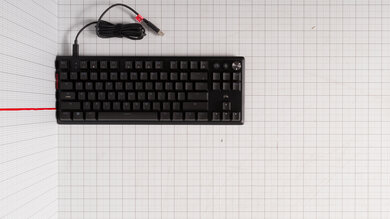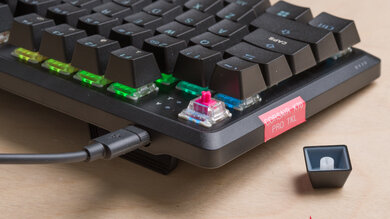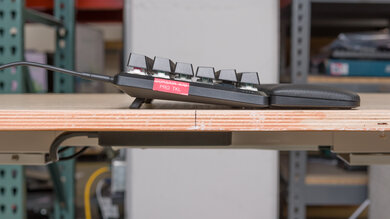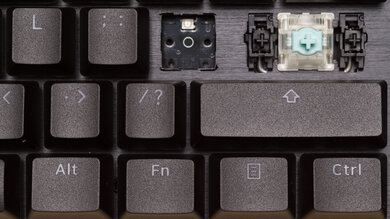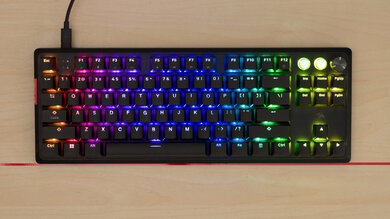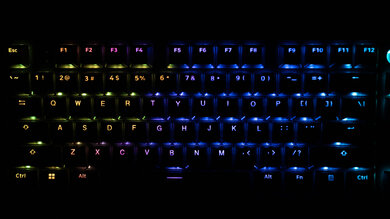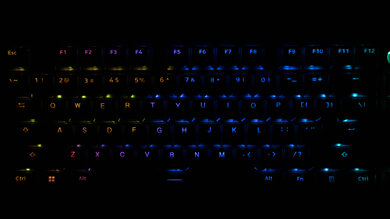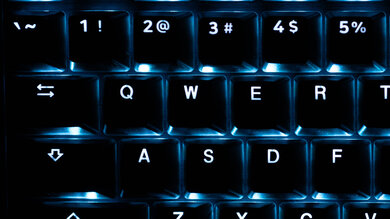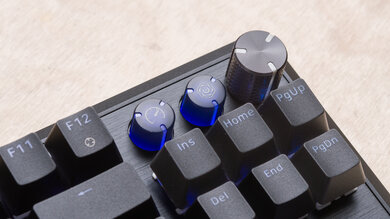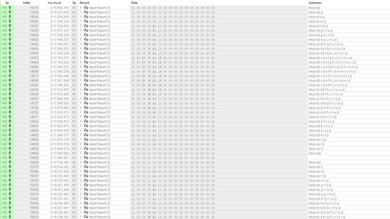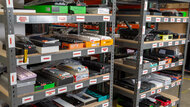The Corsair K70 PRO TKL is a tenkeyless gaming keyboard with Hall effect switches that continues Corsair’s longstanding K70 lineup. Its switches are fully adjustable, allowing per-key customization of actuation and reset points using shortcuts or the configuration software. In addition to RGB backlighting controls, custom profiles, macros, and other expected settings, the software also supports advanced features like Rapid Trigger, SOCD, and multi-action key mapping.
Our Verdict
The Corsair K70 PRO TKL is an excellent keyboard for gaming. It has good build quality and remarkably good latency performance, with a maximum effective update rate of 8000Hz. Most of the keys use Hall effect switches that allow you to customize the performance of individual keys, and the software supports more advanced options like secondary actuation points and Rapid Trigger, which can be particularly helpful for counter-strafing in FPS titles.
-
Good build quality.
-
Remarkably low latency.
-
Full RGB backlighting and clear shine-through legends.
-
8000Hz effective update rate.
-
23 switches are conventional mechanical switches rather than adjustable Hall effect switches.
While it isn't designed specifically for this use, the Corsair K70 PRO TKL is alright for office use. It has good build quality and comes with a wrist rest so you don't need to angle your wrists too steeply to reach the keys. Unfortunately, while the typing quality is good overall there's some minor key wobble and stabilizer rattle, particularly on the backspace key. Lastly, not all switches are Hall effect switches as some are mechanical. While both switch types are linear and feel similar, the typing feel is slightly inconsistent overall and may be irritating for some.
-
Good build quality.
-
Minor key wobble and stabilizer rattle.
-
23 switches are conventional mechanical switches rather than adjustable Hall effect switches.
The Corsair K70 PRO TKL is a wired-only keyboard that isn't suitable for use with mobile devices or tablets.
The Corsair K70 PRO TKL is decent for programming use. It has good overall build quality and individually backlit keys with shine-through legends that you can easily read in darker rooms. The typing quality is generally good, but keys wobble a bit, and the backspace on our unit rattled somewhat, though these issues aren't very noticeable while typing normally. You can program macros to any key, but unfortunately, there aren't any dedicated macro keys.
-
Good build quality.
-
Minor key wobble and stabilizer rattle.
-
23 switches are conventional mechanical switches rather than adjustable Hall effect switches.
The Corsair K70 PRO TKL isn't well-suited for entertainment or home theatre PC setups. It's a wired-only keyboard, so you need to sit quite close to your PC to use it. It also lacks a full set of dedicated media keys. That said, you can control media playback with a button and rotary dial in the top right corner of the keyboard, and it has full backlighting with shine-through legends that are easy to read in the dark.
-
Full RGB backlighting and clear shine-through legends.
-
Wired-only
-
Lacks a full set of dedicated media keys.
The Corsair K70 PRO TKL offers excellent raw performance with outstanding single-key and multi-key latency. It also has full n-key rollover and an effective update of 8000Hz that isn't bottlenecked by other latency components. Overall, this keyboard provides a consistent and responsive experience for gaming in any genre at any competitive level.
-
Remarkably low latency.
-
8000Hz effective update rate.
- 8.6 Gaming
- 6.7 Office
- 1.4 Mobile/Tablet
- 7.2 Programming
- 3.2 Entertainment / HTPC
- 8.9 Raw Performance
Changelog
- Updated Jun 21, 2025: We've updated this review with our new Test Bench 1.4 methodology. It adds a new Output Type classification in the Switches box, indicating whether the keyboard's output is non-adjustable, adjustable, or analog. It also introduces a new Adjustable Input Granularity test, which improves comparability between keyboards with adjustable input.
-
Updated Feb 28, 2025:
We've retested this keyboard on newer firmware (iCue 5.24) and added a correction to the Single-Key and Multi-Key Latency sections regarding Game Mode settings which override custom actuation points. Our original text listed that the actuation distance we used for testing was 0.1mm but the distance is in fact 1.0 mm due to the Game Mode override. Note that our scores haven't changed following this retest.
- Updated Feb 17, 2025: Review published.
- Updated Feb 07, 2025: Early access published.
- Updated Feb 03, 2025: Our testers have started testing this product.
Check Price
Differences Between Sizes And Variants
The Corsair K70 PRO TKL comes in a Black or White colorway and with a choice of ABS double-shot keycaps or PBT double-shot keycaps. We bought and tested the Black color version with ABS keycaps. See an image of our unit's label.
Compared To Other Keyboards
The Corsair K70 PRO TKL joins the rapidly growing market of gaming keyboards with Hall effect switches. These boards support analog features like Rapid Trigger, which can give you a noticeable advantage when playing some titles, like rhythm games or FPS titles. It has remarkably good performance and supports 8000Hz polling, so it handily competes with other popular analog options like the Razer Huntsman V3 Pro TKL, the NuPhy Field75 HE, and the Wooting 80HE. One element that sets it apart is support for actuation adjustments on the fly with shortcuts, which is somewhat uncommon. This makes it a great choice if you prefer onboard adjustments or want to use this keyboard with a device that isn't compatible with the software, such as a gaming console.
One oddity worth mentioning is that 23 switches on this keyboard are conventional mechanical switches, not Hall effect switches. We've encountered this with some other major gaming brand models like the SteelSeries Apex Pro Gen 3. While these switches (which include the function row, arrow keys, and navigation cluster keys) are unlikely to be keys, you'll want to adjust them for gameplay reasons. Some may see it as a needless cost-cutting oversight, and it affects the consistency of the overall typing experience as these keys feel similar but not exactly the same.
For more recommendations, see our picks for the best keyboards, the best gaming keyboards, and the best TKL keyboards.
The Wooting 80HE and Corsair K70 PRO TKL are tenkeyless analog gaming keyboards. The Wooting offers better overall performance and a more premium feel. It also provides both web-based and offline configuration software, along with advanced features the Corsair lacks, such as joystick analog control. In comparison, the Corsair includes a multi-function rotary knob and a wrist rest—features missing on the Wooting.
The Corsair K70 RGB TKL and Corsair K70 PRO TKL are tenkeyless gaming keyboards from the same lineup, offering similar raw gaming performance. The main difference is that the K70 RGB TKL uses conventional mechanical or optical switches, while the K70 PRO TKL features Hall effect switches, enabling per-key actuation and reset point adjustments. There are also some minor design distinctions—the K70 RGB TKL includes a full set of dedicated media keys and a volume roller but lacks a wrist rest, whereas the K70 PRO TKL primarily uses a button and rotary dial for media control and comes with a wrist rest.
The SteelSeries Apex Pro TKL (2023) and Corsair K70 PRO TKL are tenkeyless analog gaming keyboards equipped with Hall effect switches. The SteelSeries stands out with its customizable OLED screen, while the Corsair offers slightly better overall performance, supports a higher 8000Hz maximum polling rate, and features a multi-function rotary knob instead.
The Corsair K70 MAX and Corsair K70 PRO TKL are analog gaming keyboards within the same lineup. The K70 MAX is a full-size model with Hall effect switches on all keys, a complete set of dedicated media keys, and a volume roller. In contrast, the K70 PRO TKL has a more compact tenkeyless design, with most—but not all—keys using Hall effect switches, as some are non-adjustable mechanical switches. It forgoes a full set of dedicated media keys, instead using a button and a multi-function rotary dial for media control.
Test Results
The Corsair K70 PRO TKL has a compact tenkeyless layout. It doesn't take up quite as much space as a full-size keyboard as it's missing a Numpad.
It also comes with a wrist rest that attaches magnetically. The above measurements are without the wrist rest attached. With the wrist rest, the keyboard weighs 2.25 lbs (1.15kg)
The Corsair K70 PRO TKL has good overall build quality. The chassis is made of plastic, and the switch plate is aluminum. The entire deck feels very sturdy and doesn't exhibit any flexing.
Unfortunately, the keycaps on the model we bought are made of ABS plastic. ABS keycaps feel a bit cheap and tend to develop a shiny, slightly slippery finish after prolonged use. However, you can choose to buy this keyboard with PBT keycaps instead, which are higher quality, more durable, and slightly textured.
There are foam inserts under the spacebar which do help minimize the hollow feeling some spacebars exhibit.
Four rubber strips on the underside that do a good job of keeping the board from sliding around on your desk.
This keyboard also includes a leatherette wrist rest, which is fairly soft but provides good support.
This keyboard has a fairly tall standard profile. Thankfully, it comes with a wrist rest that attaches magnetically. It provides good support and ensures you don't have to bend your wrists steeply upwards to reach the keys while using it.
This keyboard also provides an additional incline setting with a pair of flip-out feet on the underside.
The Corsair K70 PRO TKL offers okay hardware customizability. None of the switches are soldered to the PCB, so it's technically hot-swappable. However, Corsair doesn't sell replacement CORSAIR MGX Hyperdrive switches, and to our knowledge, other Hall effect switches on the market aren't compatible with this keyboard.
The PCB has north-facing LEDs, and the switches are installed north-facing out of the box. Due to this north-facing orientation, there is a possibility of interference with some aftermarket sets of Cherry MX profile keycaps.
While you can rotate the switches 180 degrees into a south-facing orientation this significantly impacts backlight clarity for the shine-through keycaps. It can also affect actuation accuracy and may potentially damage the PCB, so we don't recommend it.
This keyboard has a detachable, braided USB-C cable with a Corsair logo on each connector. Unfortunately, the cable does retain some kinks from its packaging.
This is a wired-only keyboard.
In the top right corner of the Corsair K70 PRO TKL, there are a set of two buttons and one rotary knob.
- The button on the left activates a Gaming Mode profile, which toggles several combined settings for optimal gaming performance. These include static backlighting, Win lock, and actuation settings that you can customize using the software.
- The middle button controls media playback by default and can be further customized in software.
- The rotary dial on the right controls media volume by default. You can also use it to adjust backlighting, scroll horizontally through web content, or zoom in on certain applications.
There are LED indicators for Caps Lock and Scroll Lock on the left side of the keyboard, next to the F1 key.
This keyboard is compatible with Xbox One and Xbox Series X/S consoles out of the box, and there's a shortcut for activating a PlayStation mode for connecting your keyboard to a Sony PlayStation 4 or 5.
When you're not actively using the software, or you've connected your keyboard to a device that doesn't support the iCUE configuration software (such as a game console), the keyboard has a shortcut-activated hardware mode that allows you to make simplified changes to settings such as backlighting or actuation point presets.
For a full list of supported shortcuts for compatibility modes, media controls, polling rate adjustment, backlighting, and actuation presets, see an online version of the user manual on Corsair's website.
The Corsair K70 PRO TKL provides a good overall typing experience. The keys have normal spacing, and the keycaps have a standard OEM profile.
There's some key wobble and minor stabilizer rattle, particularly on the Backspace key, which feels under-lubbed. That said, these issues aren't particularly noticeable while typing. Unfortunately, the keycaps on the unit we bought are made of ABS plastic which feels a bit cheap. This keyboard is also available with PBT keycaps, which generally have a better, slightly textured feel and aren't prone to getting slippery over time, a common issue for ABS keycaps.
There are a layers of sound dampening material inside the case that make it a bit quieter compared to the similar Corsair K70 MAX. However, these layers don't do much to dampen the feeling of bottoming out your keystrokes, which can be an issue if you're a heavy typist.
This keyboard's typing noise is quiet, and it's unlikely to bother those around you, even in noise-sensitive environments.
You can change or adjust the actuation point of the CORSAIR MGX Hyperdrive switches between 0.1 mm and 4.0 mm using the configuration software.
For this test, we used an actuation point setting of 0.1 mm with a Rapid Trigger setting of 0.1 mm. However, the actual measured actuation point at this setting was closer to 0.3 mm.
For reference, we measured additional actuation point settings below:
Setting 0.5 mm: actuation 0.88 mm
Setting 1.0 mm: actuation 1.19 mm
Setting 1.5 mm: actuation 1.65 mm
Setting 2.0 mm: actuation 2.13 mm
Setting 2.5 mm: actuation 2.58 mm
Setting 3.0 mm: actuation 3.06 mm
Setting 3.5 mm: actuation 3.52 mm
Setting 4.0 mm: actuation 3.64 mm
The actuation settings are generally very accurate, with minor inaccuracies at the very lowest and highest actuation settings.
The majority of the switches on the Corsair K70 PRO TKL are CORSAIR MGX Hyperdrive Hall effect switches. However, 23 switches (including the entire function row, navigation cluster, and arrow keys) are CORSAIR MLX Plasma linear switches, which are conventional mechanical switches that do not support adjustable actuation. See an image of all Hall effect switches highlighted.
We've also recorded a stem wobble video for the CORSAIR MLX Plasma linear switches.
The Corsair K70 PRO TKL has outstanding single-key latency, offering an extremely responsive experience for gaming in any genre at any competitive level.
We conducted this test using the following settings:
- Gaming Mode: On
- Polling rate: 8000Hz
- Actuation: 1.0 mm
- Rapid Trigger: 0.1 mm (downstroke) and 0.1 mm (upstroke)
Using Game Mode overrides any custom actuation distance settings and locks the actuation distance to 1.0 mm, but Rapid Trigger remains enabled and adjustable. For more details and supplementary measurements with Game Mode off, see our text in the Multi-Key Latency section.
The Corsair K70 PRO TKL delivers remarkably good multi-key latency performance, making it well-suited for playing any game that requires additional keystrokes while multiple keys are pressed and maintained.
We conducted this test using the following settings:
- Gaming Mode: On
- Polling rate: 8000Hz
- Actuation: 1.0 mm
- Rapid Trigger: 0.1 mm (downstroke) and 0.1 mm (upstroke)
Enabling Game Mode overrides any custom actuation distance settings and locks the actuation distance to 1.0 mm, but Rapid Trigger remains enabled and adjustable.
For reference, we also performed extra testing with Game Mode Off. We've opted to use the Game Mode results for scoring as this mode provides the most balanced latency performance. Keeping Game Mode disabled produces marginally lower press latency if you set the actuation distance to 0.1mm, but this comes with a cost of significantly more release latency.
This keyboard can send multiple keys per USB report and supports full N-key rollover by default.
It also has an effective update rate of 8000Hz, so it doesn't suffer from a performance bottleneck and can take advantage of the maximum 8000Hz polling rate.
This keyboard offers decent overall chord split performance. However, its slightly higher-than-typical 4-chord split delay makes it less ideal for rhythm games or other titles that require precise registration of multiple simultaneous key presses.
The software is easy to use but can be a bit overwhelming if you aren't used to analog gaming keyboards. It allows you to customize a range of expected settings, including macros, backlighting effects, and polling rate, among others.
You can save your custom settings to the keyboard's onboard memory, so you don't have to have the software running in the background.
The Key Actuations section of the software lets you customize switch behavior, including actuation and reset points. Note that only the highlighted keys are adjustable.
This section also includes more advanced analog key settings, detailed below.
Secondary Actuation Point: Allows you to program a second action to a single key that will trigger depending on actuation distance
Rapid Trigger: This setting can dynamically adjust actuation and reset points. This allows for faster follow-up inputs, which can be especially beneficial in scenarios like counter-strafing in FPS games.
Flashtap (SOCD): Specifies a pair of two keys with custom trigger behavior along three possible parameters: 1) Last priority, where your last input is always prioritized. 2) Neutral, where neither key activates when both are triggered at the same time. 3) First priority, where the first key always overrides the other.
Disclaimer: Using this setting may be disallowed in some competitive online games, such as CS:2.
This keyboard is fully compatible with all major operating systems.
In Windows, all default key functions work as expected. In macOS, there is a compatible software version, and several keys behave a bit differently. Namely, the PrtSc key acts as an 'F13' key, the F11 key minimizes the active window, and the Pause and ScrLk keys increase and decrease screen brightness, respectively.
For Linux, all but default key functions work as expected, but there's no compatible software.
Comments
Corsair K70 PRO TKL: Main Discussion
Let us know why you want us to review the product here, or encourage others to vote for this product.
Update: We’ve updated this review with our new Test Bench 1.4 methodology. It adds a new Output Type classification in the Switches box, indicating whether the keyboard’s output is non-adjustable, adjustable, or analog. It also introduces a new Adjustable Input Granularity test, which improves comparability between keyboards with adjustable input.
- 32120
Was the latency tested on icue version 5.23 or 5.24? If using version 5.23 the actuation point setting would have been overrided by game mode so it would be at 1mm instead of 0.1mm
Hi arti! Thanks you for reaching out! When I tested, the latest version of iCUE was 5.23. I compared the actuation point setting with Game Mode enabled and disabled, as you mentioned, and found that you are correct and the actuation does change between both modes. It’s even present in the updated version 5.24. Retesting the latency with Game Mode off showed a slight improvement in key press speed (from 2.4ms to 1.8ms) but a negative impact on key release (increasing from 5.4ms to 12.7ms). Thanks again for the insight! If there’s anything else you’d like us to test, just let us know! 😃
- 32120
Was the latency tested on icue version 5.23 or 5.24? If using version 5.23 the actuation point setting would have been overrided by game mode so it would be at 1mm instead of 0.1mm
The full review has been posted here. Let us know what you think!
- 2102-1
Awesome. I have the huntsman v3 pro mini and the Corsair k70 pro tkl. I would have been happier with wooting 80he or the field 75 he or the air 75he. Both of the ones I own are lackluster. I like the low profile layout personally which could contribute to perceived latency as well.
I normally don’t use the low profile layout all the keyboards I’ve used are normal profile but after using the air 75he I don’t mind it sounds way better and the switches feel smooth “ jade pro ”
- 43230
Awesome. I have the huntsman v3 pro mini and the Corsair k70 pro tkl. I would have been happier with wooting 80he or the field 75 he or the air 75he. Both of the ones I own are lackluster. I like the low profile layout personally which could contribute to perceived latency as well.
- 10-11-1
Ye i agree the nuphy field 75 he is crazy good for the price its 150 dollars and for me 40dollars more for shipping from them directly, but in my country its 230 dollars, ill see
well, I have tested apex pro gen 3 and Huntsman v3 pro neither of them is worth your money coz one comes with red switches and the other can’t use RT on lowest settings coz it sometimes causes spamming input, I bought the Nuphy air75he coz wooting cost a bit high than alternative and their support takes ages to reply


